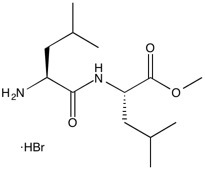Leu-Leu-OMe HBr | Lysosomal damaging agent
NMR (Conforms)

Available Options
| Size : | Price | Quantity | |
|---|---|---|---|
| 20 mg | $45.00 | ||
| 100 mg | $150.00 |
Leu-Leu-OMe (16689-14-8) is a lysosomal damaging agent (lysosomotropic). It is condensed into a membranolytic polymer via the transpeptidase action of cathepsin C within lysosomes.1,2 May be used to induce a lysosomal damage model in cells.3,4 LLOMe-induced lysosomal damage elicits ubiquitin puncta formation on lysosomes.1 Induces apoptosis in human mast cells via lysosome destabilization leaving fibroblasts and HEK-293 cells largely resistant.5 Induces lysophagy.4
References/Citations:
1) Maejima et al. (2013), Autophagy sequesters damaged lysosomes to control lysosomal biogenesis and kidney injury; EMBO J., 32 2336
2) Fujita et al. (2013), Recruitment of the autophagic machinery to endosomes during infection is mediated by ubiquitin; J. Cell Biol., 203 115
3) Chauhan et al. (2016), TRIMS and Galectins Globally Cooperate and TRIM16 and Galectin-3 Co-directed Autophagy in Endomembrane Damage Homeostasis; Dev. Cell, 39 13
4) Otomo and Yoshimori (2017), Lysophagy: A Method for Monitoring Lysosomal Rupture Followed by Autophagy-Dependent Recovery; Methods Mol. Biol. 1594 141
5) Melo et al. (2011), Lysosomal membrane permeabilization induces cell death in human mast cells; Scand. J. Immunol., 74 354
NMR (Conforms)
Safety Data Sheet:
Product Data Sheet:
Materials provided by Focus Biomolecules are for laboratory research use only and are not intended for human or veterinary applications. Please note that we do not sell to individuals and that all orders placed by non-research organizations will incur a $20 restocking/refund fee
Leu-Leu-OMe (16689-14-8) is a lysosomal damaging agent (lysosomotropic). It is condensed into a membranolytic polymer via the transpeptidase action of cathepsin C within lysosomes.1,2 May be used to induce a lysosomal damage model in cells.3,4 LLOMe-induced lysosomal damage elicits ubiquitin puncta formation on lysosomes.1 Induces apoptosis in human mast cells via lysosome destabilization leaving fibroblasts and HEK-293 cells largely resistant.5 Induces lysophagy.4
References/Citations:
1) Maejima et al. (2013), Autophagy sequesters damaged lysosomes to control lysosomal biogenesis and kidney injury; EMBO J., 32 2336
2) Fujita et al. (2013), Recruitment of the autophagic machinery to endosomes during infection is mediated by ubiquitin; J. Cell Biol., 203 115
3) Chauhan et al. (2016), TRIMS and Galectins Globally Cooperate and TRIM16 and Galectin-3 Co-directed Autophagy in Endomembrane Damage Homeostasis; Dev. Cell, 39 13
4) Otomo and Yoshimori (2017), Lysophagy: A Method for Monitoring Lysosomal Rupture Followed by Autophagy-Dependent Recovery; Methods Mol. Biol. 1594 141
5) Melo et al. (2011), Lysosomal membrane permeabilization induces cell death in human mast cells; Scand. J. Immunol., 74 354
Calculate the molar concentration, mass or volume in a solution.
Concentration × Volume × Molecular Weight = Mass
Focus Biomolecules • Plymouth Meeting, PA USA • 1-855-FOCUS21
Focus Biomolecules
Plymouth Meeting, PA USA
1-855-FOCUS21
Website Created by Advanta Advertising LLC.

